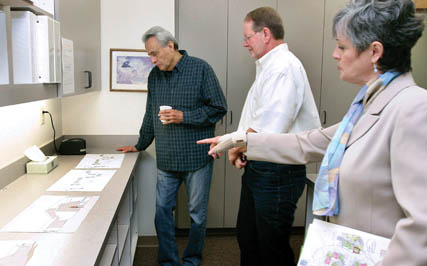Tribal Government & News
HUD's Native American Program head visits Grand Ronde

Smoke Signals staff writer
"You're blessed with having such great sites," said Rodger Boyd (Navajo), Deputy Assistant Secretary of the federal Housing and Urban Development's Office of Native American Programs, "and the architecture and layouts really complement them. The integration of housing design and cultural awareness is extremely good. It's a great combination."
In Portland to talk at a Community Development Financial Institutions conference, Boyd, the top official within the Office of Native American Programs, spoke during a July 20 side trip to look at Tribal housing and other HUD projects in Oregon, starting with the Confederated Tribes of Grand Ronde.
Boyd and Office of Native American Programs Northwest Regional Director Ken Bowring toured the Housing Authority communities and the Tribal campus, with narration provided by Grand Ronde Tribal Housing Authority Executive Director Carina Kistler with the assistance of Rental Housing Coordinator Leon Ramos.
"It is a great honor for Mr. Boyd's first stop at an Oregon Tribe to be here in Grand Ronde," Kistler said. "We are excited to show him the results of 12 years of housing and facilities made possible through HUD funding."
The tour included the Housing Authority office, Grand Meadows (Homeownership Housing), Chxi Musam Illihi (Family Rental Housing), Ilip Tilixam (Elder Rental Housing), the three Adult Foster Care lodges and the Elders' Activity Center. They also visited the Tribe's Indian Community Development Block Grant projects, including the new Tribal Library expansion and the two additions to the Health and Wellness Center. All are beneficiaries of Housing and Urban Development funding.
"I want to say how much I appreciate what HUD has done, not only for the clinic but for the whole Tribe," said Health Services Executive Director Mark Johnston. "You can't go anywhere on this campus without seeing the HUD stamp."
"What I love is people are seeing these as 'our' buildings, not 'HUD' buildings," Boyd said, referring to art commissioned for different buildings, such as the murals on Elder Housing units.
"It's our funds," said Bowring, "but you (local community) do the heavy lifting."
While HUD properties sometimes come with a negative connotation across the country, Boyd said he is seeing "new designs determined by the community itself, reflective of the local culture."
"What has impressed me is the consistency of really good use of (HUD) funds," he said.
These projects show "the time, commitment and effort" these local communities are putting into their projects.
Regarding budget talks in Washington, D.C., Boyd said that the Tribes have helped themselves by using 85 percent to 90 percent of available funding from the American Reinvestment and Recovery Act of 2009.
In Grand Ronde, the Housing Authority received one ARRA grant and made use of 90 percent of it. The other HUD ARRA grant on campus was the $600,000 Health Clinic addition, and the Tribe used 100 percent of those funds.
"They demonstrated to the administration the need across Indian Country," and that Tribal people have "the capacity to do really good projects."
All this contributed to the education of policy makers, Boyd said.
"They're beginning to see what the real need is."
In addition to quality work, Boyd said that Tribes are benefiting as they become "more sophisticated about leveraging HUD funds" with other funding sources and tax credits.
The administration asked for $580 million in funding for 2011, Boyd said, and because of the record in Indian Country, the administration added $120 million to the request for 2012.
Boyd also was interested in details beyond the building processes. At the newly expanded Tribal Library, Tribal Elder and Librarian Marion Mercier described the range of ages that library programs serve.
"They're introduced to the library program at a very young age," he observed. "That's very important."
